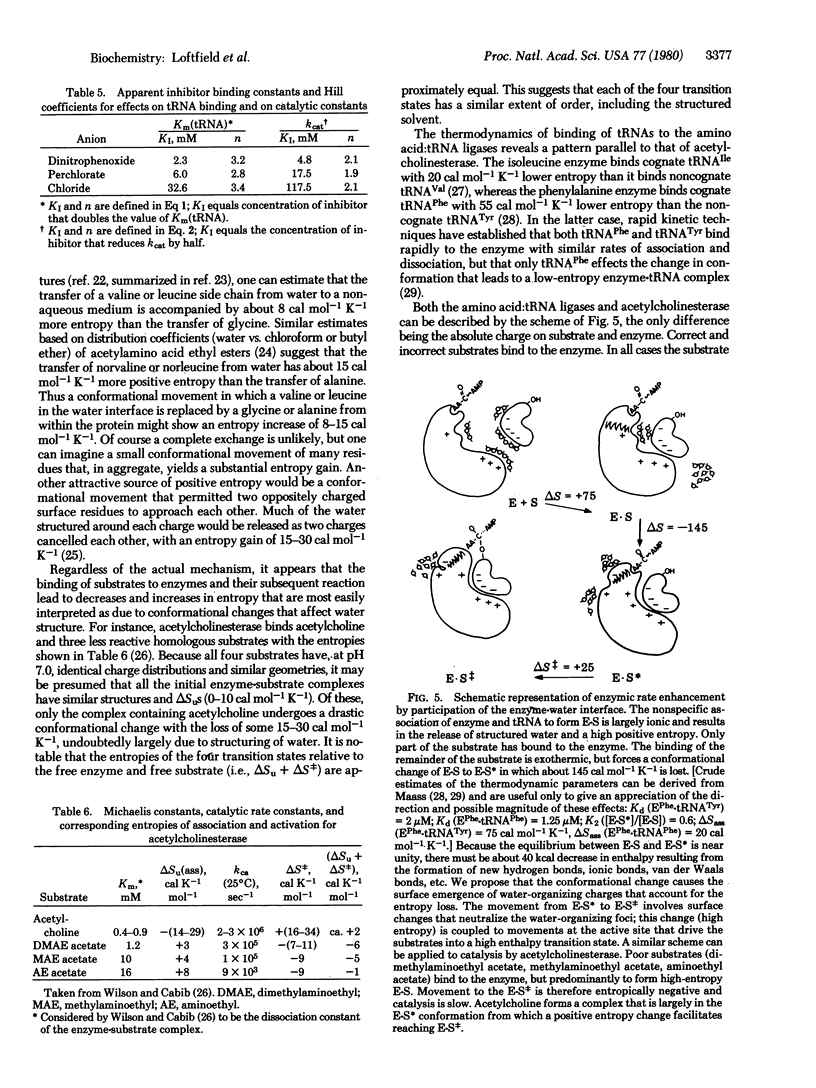Abstract
The entropy of activation for the synthesis of Ile-tRNA is high and positive. The only likely source of a high delta S is the loss of structured water as the enzyme . substrate complex moves toward the transition state. This requires a change in the orientation or nature of water-organizing residues in the interface between the enzyme . substrate complex and the water. Such changes, which may be some distance from the "active site," are coupled to the active site in such a way that the increased entropy and decreased free energy of the water--enzyme interface is available at the "active site" to reduce the free energy of activation. The effects of Hofmeister anions on KmS and KcatS are consistent with the entropy data.
Full text
PDF




Selected References
These references are in PubMed. This may not be the complete list of references from this article.
- Carr A. C., Igloi G. L., Penzer G. R., Plumbridge J. A. The effects of spermine and Mg2+ on the catalytic mechanism of isoleucine: tRNA ligase. Eur J Biochem. 1975 May;54(1):169–173. doi: 10.1111/j.1432-1033.1975.tb04126.x. [DOI] [PubMed] [Google Scholar]
- Charlier J., Grosjean H. Isoleucyl-transfer ribonucleic acid synthetase from Bacillus stearothermophilus. I. Properties of the enzyme. Eur J Biochem. 1972 Jan 31;25(1):163–174. doi: 10.1111/j.1432-1033.1972.tb01681.x. [DOI] [PubMed] [Google Scholar]
- Eigner E. A., Loftfield R. B. Kinetic techniques for the investigation of amino acid: tRNA ligases (aminoacyl-tRNA synthetases, amino acid activating enzymes). Methods Enzymol. 1974;29:601–619. doi: 10.1016/0076-6879(74)29053-0. [DOI] [PubMed] [Google Scholar]
- Fridovich I. A study of the interaction of acetoacetic decarboxylase with several inhibitors. J Biol Chem. 1968 Mar 10;243(5):1043–1051. [PubMed] [Google Scholar]
- Gillam I., Millward S., Blew D., von Tigerstrom M., Wimmer E., Tener G. M. The separation of soluble ribonucleic acids on benzoylated diethylaminoethylcellulose. Biochemistry. 1967 Oct;6(10):3043–3056. doi: 10.1021/bi00862a011. [DOI] [PubMed] [Google Scholar]
- HOAGLAND M. B., ZAMECNIK P. C., SHARON N., LIPMANN F., STULBERG M. P., BOYER P. D. Oxygen transfer to AMP in the enzymic synthesis of the hydroxamate of tryptophan. Biochim Biophys Acta. 1957 Oct;26(1):215–217. doi: 10.1016/0006-3002(57)90081-1. [DOI] [PubMed] [Google Scholar]
- HOFSTEE B. H. J. On the evaluation of the constants Vm and KM in enzyme reactions. Science. 1952 Sep 26;116(3013):329–331. doi: 10.1126/science.116.3013.329. [DOI] [PubMed] [Google Scholar]
- Jencks W. P. Binding energy, specificity, and enzymic catalysis: the circe effect. Adv Enzymol Relat Areas Mol Biol. 1975;43:219–410. doi: 10.1002/9780470122884.ch4. [DOI] [PubMed] [Google Scholar]
- Krauss G., Riesner D., Maass G. Mechanism of discrimination between cognate and non-cognate tRNAs by phenylalanyl-tRNA synthetase from yeast. Eur J Biochem. 1976 Sep;68(1):81–93. doi: 10.1111/j.1432-1033.1976.tb10766.x. [DOI] [PubMed] [Google Scholar]
- Lam S. S., Schimmel P. R. Equilibrium measurements of cognate and noncognate interactions between aminoacyl transfer RNA synthetases and transfer RNA. Biochemistry. 1975 Jun 17;14(12):2775–2780. doi: 10.1021/bi00683a034. [DOI] [PubMed] [Google Scholar]
- Loftfield R. B., Eigner E. A. General base catalysis in the reactions of transfer ribonucleic acid ligases. Biochemistry. 1968 Mar;7(3):1100–1105. doi: 10.1021/bi00843a030. [DOI] [PubMed] [Google Scholar]
- Loftfield R. B., Eigner E. A. Molecular order of participation of inhibitors (or activators) in biological systems. Science. 1969 Apr 18;164(3877):305–308. doi: 10.1126/science.164.3877.305. [DOI] [PubMed] [Google Scholar]
- Loftfield R. B., Eigner E. A. The specificity of enzymic reactions. Aminoacyl-soluble RNA ligases. Biochim Biophys Acta. 1966 Dec 28;130(2):426–448. doi: 10.1016/0304-4165(66)90239-x. [DOI] [PubMed] [Google Scholar]
- Low P. S., Somero G. N. Activation volumes in enzymic catalysis: their sources and modification by low-molecular-weight solutes. Proc Natl Acad Sci U S A. 1975 Aug;72(8):3014–3018. doi: 10.1073/pnas.72.8.3014. [DOI] [PMC free article] [PubMed] [Google Scholar]
- Low P. S., Somero G. N. Protein hydration changes during catalysis: a new mechanism of enzymic rate-enhancement and ion activation/inhibition of catalysis. Proc Natl Acad Sci U S A. 1975 Sep;72(9):3305–3309. doi: 10.1073/pnas.72.9.3305. [DOI] [PMC free article] [PubMed] [Google Scholar]
- Lõvgren T. N., Heinonen J., Loftfield R. B. The mechanism of aminoacylation of transfer ribonucleic acid. Reactivity of enzyme-bound isoleucyl adenylate. J Biol Chem. 1975 May 25;250(10):3854–3860. [PubMed] [Google Scholar]
- Lövgren T. N., Pastuszyn A., Loftfield R. B. The mechanism of the aminoacylation of transfer ribonucleic acid: enzyme-product dissociation is not rate limiting. Biochemistry. 1976 Jun 15;15(12):2533–2540. doi: 10.1021/bi00657a007. [DOI] [PubMed] [Google Scholar]
- Lövgren T. N., Petersson A., Loftfield R. B. The mechanism of aminoacylation of transfer ribonucleic acid. The role of magnesium and spermine in the synthesis of isoleucyl-tRNA. J Biol Chem. 1978 Oct 10;253(19):6702–6710. [PubMed] [Google Scholar]
- NISHIMURA S., JACOB T. M., KHORANA H. G. SYNTHETIC DEOXYRIBOPOLYNUCLEOTIDES AS TEMPLATES FOR RIBONUCLEIC ACID POLYMERASE: THE FORMATION AND CHARACTERIZATION OF A RIBOPOLYNUCLEOTIDE WITH A REPEATING TRINUCLEOTIDE SEQUENCE. Proc Natl Acad Sci U S A. 1964 Dec;52:1494–1501. doi: 10.1073/pnas.52.6.1494. [DOI] [PMC free article] [PubMed] [Google Scholar]
- Nandi P. K., Robinson D. R. The effects of salts on the free energies of nonpolar groups in model peptides. J Am Chem Soc. 1972 Feb 23;94(4):1308–1315. doi: 10.1021/ja00759a043. [DOI] [PubMed] [Google Scholar]
- Riesner D., Pingoud A., Boehme D., Peters F., Maass G. Distinct steps in the specific binding of tRNA to aminoacyl-tRNA synthetase. Temperature-jump studies on the serine-specific system from yeast and the tyrosine-specific system from Escherichia coli. Eur J Biochem. 1976 Sep;68(1):71–80. doi: 10.1111/j.1432-1033.1976.tb10765.x. [DOI] [PubMed] [Google Scholar]
- Yarus M., Berg P. Recognition of tRNA by isoleucyl-tRNA synthetase. Effect of substrates on the dynamics of tRNA-enzyme interaction. J Mol Biol. 1969 Jun 14;42(2):171–189. doi: 10.1016/0022-2836(69)90037-0. [DOI] [PubMed] [Google Scholar]


